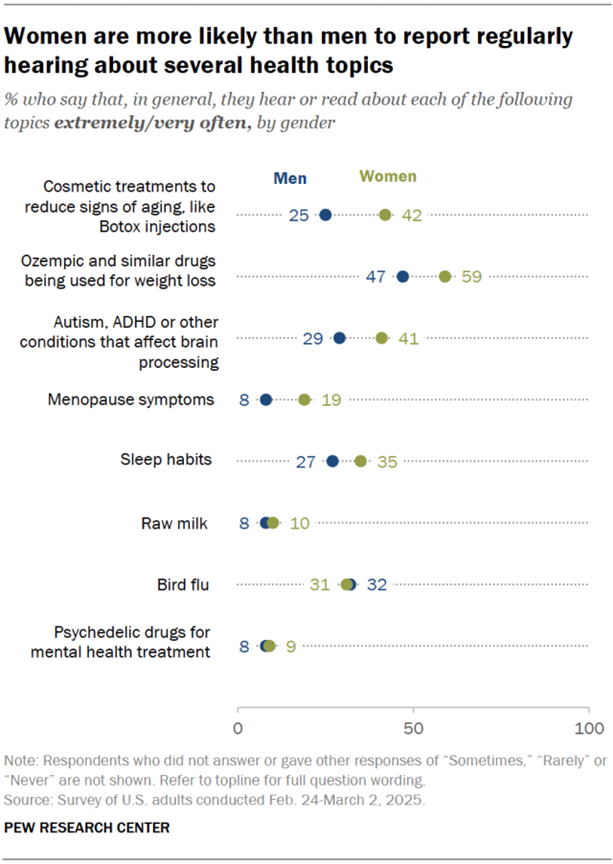HealthPopuli.com – Read More
Yu In a sign of our health communications times, GLP-1s are a much more frequently health topic Americans hear about than autism and ADHD, cosmetic treatments like Botox, Bird flu, sleep issues, or menopause.
The Pew Research Center polled 5,123 U.S. consumers in February and March 2025 to gauge peoples’ perspectives on health information and communications trends in America.

In the study summary titled, From weight-loss drugs to raw milk, Americans hear more often about some health topics than others, the Pew Research team. The finding that 53% of Americans hear about Ozempic and similar drugs for weight loss (the GLP-1 category and others) significantly rises above those people hearing extremely or very often about autism/ADHD and cosmetic treatments — at 35%.
That calculates to 50% more people hearing very often about the weight loss drugs versus medicines or treatments for ADHD or treatments for aging.
In the Pew Research team’s methodology, the channels covered for these communications included news, social media, and conversations. Note that GLP-1s were responsible for the top two drugs ranked by U.S. spending in 2024 — Semaglutide (Ozempic, Wegovy et al) and Tirzepatide (Mounjaro and Zepbound) on which pharma companies spent money for DTC advertising in 2024.

There is also a relationship between the top-revenue generators among prescription drugs in the U.S. and those for which pharma companies allocate direct-to-consumer advertising dollars. For example, Companies spent more than $1 billion on ads for weight loss and diabetes medicines in 2023, up 51% from the prior year, according to new data from advertising analytics firm MediaRadar. That’s nearly 15% of drugmakers’ $7.6 billion in ad spending for prescription drugs last year. Add in spending on Jardiance (#5 on the list).
Here is a list of 2024 DTC spending on the six top drugs in the category according to MediaRadar:
- Wegovy: $263 million
- Ozempic: $208 million
- Rybelsus: $199 million
- Jardiance: $148 million
- Mounjaro: $139 million
- Farxiga: $68 million.
According to MediaRadar, “National TV is overwhelmingly the top format for weight loss and diabetes drug advertising so far in 2024,” thus driving up consumers’ awareness for the GLP-1 drugs in mass media. Social media outlets, like TikTok, are also popular platforms for patients sharing personal experiences using this group of meds.

The Pew research also looked at differences between men and women’s exposure to health topics, the results of which are shown in the second chart. Women were more likely to hear about Ozempic and similar drugs for weight loss (59% for women versus 47% of men), cosmetic treatments to reduce signs of aging (like Botox, 42% of women compared with 25% of men), treatments for autism and ADHD (41% of women vs 29% of men), and sleep habits (35% of women versus 27% of men).
Other categories, such as Bird flu, psychedelic drugs for mental health treatment, and raw milk a therapeutic beverage were closer in exposure/recollection across gender.
For menopause, women heard about the topic extremely or very often by a factor of more than two to one: 19% of women compared with 8% of men.
The report looked further into women’s perspectives on menopause symptoms in media and conversations, with women between 40 and 59 years of age being most likely to hear about these issues extremely or very often compared with younger (ages 18-39) and older (60+) women.
For men, six in ten say they “rarely” or “never” hear about menopause symptoms. (You’ll hear a lot more about men’s health from me in July 2025 — no spoiler allowed at this point!).
Health Populi’s Hot Points: Two days after President Trump’s inauguration in late January 2025, I clicked onto a CDC website looking for data on a women’s health topic on which I’ve been working for many months. It was a normal and usual workflow for me in previous weeks and months in 2024.

My online search yielded a page result with the dreaded “404” message. I then performed another search, looking for a quote from Jill Biden from a speech she had recently given that I saw was quoted at the time on a White House website. That search yielded the following image, which I posted on my LinkedIn channel asking any of my 225,000+ followers on the platform whether they had experienced this kind of result searching on a U.S. Federal government health or policy-oriented website.
A few days later, after encountering this many times, I wrote this post here on Health Populi about whether people seeking health-oriented information in the U.S. would be forced in certain instances to seek that info on private sector websites.
In that essay I asked, “Can the private sector serve up sufficient health media to compensate for public sector gaps?”
Five months later, we note several events that prompt this question with more evidence base to re-ask it; three examples that are part of my own client workflows in this half of 2025….
For vaccines, Robert F. Kennedy, Jr., disbanded the previous cohort of members of the ACIP Vaccines Committee, replacing them with colleagues who have ranged from full-throated vaccine deniers to, more subtly perhaps, vaccine skeptics. The remedy? One thought is to check out the Vaccine Education Center located at the Children’s Hospital of Philadelphia website.
For HIV/AIDS resources, cuts to clinical trials, and the communication channels that serve up linkages to them, have left some patients seeking to participate in research for a lifeline they may not be able to find. We are concerned about the risk of rising infections, as just one potential risk to the well-working preventive efforts of PrEP and other approaches.
For health equity, which I work on across the health/care ecosystem, Mother Jones asked on June 4, “How are we going to implement these things….[when] you can’t even say the words ‘disparity,’ ‘inequity,’ ‘women,’ [or] ‘race?’” In addition to food (especially for children at school via #SNAP benefits), I am focusing on maternal and child health. To assure access to us for information on women’s health, you can check into the private association ACOG, the American College of Obstetricians and Gynecologists, who have major skin in this part of the healthcare game. As Dr. Steven Fleischman, newly-inducted President of ACOG, said in the Mother Jones’ coverage, “Realizing that these vital programs could lose funding or be eliminated entirely is deeply concerning and will hamper our ability as a country to track critical maternal health outcomes data and end racial health disparities.”

The Association of Health Care Journalists reminded us on June 16, 2025,
“One thing that we tell a lot of our partners is that in these kind of overwhelming times, with so much information, if you can just even focus on one thing,” Dang advised, “you don’t have to address every story or every issue, if you can just get one thing out there.”
You can check out AHCJ’s Health Data Preservation Project at this link, which includes a host of excellent sources gathering data to help us stay informed on the latest stats they can gather across a range of health issues.
In the meantime, please keep track of your experiences seeking (public) health information from public sector (Federal U.S.) websites and let me know what you find….or don’t or can’t find. We’re tracking these instances for research over the coming months. You can reach me through this blogsite’s contact form or via LinkedIn. My thanks for your vigilance.
As AHCJ observed,
“Public health is often invisible — many of the things that we see as being hallmarks of our modern comforts are public health.”
Access to science- and evidence-based information for both health citizens (patients, caregivers, parents, consumers all) and health care providers is key to bolstering the health and wellbeing of all people in the U.S. When it’s not available to us, that information is indeed invisible, adding yet another riff of a definition to the concept of “transparency” in health care.
The post Americans Hear More Frequently About GLP-1 Drugs Than About Menopause, Sleep, or Bird Flu appeared first on HealthPopuli.com.





